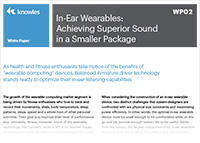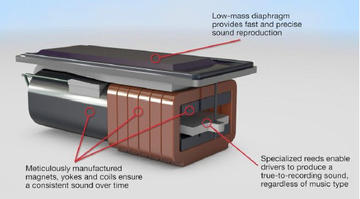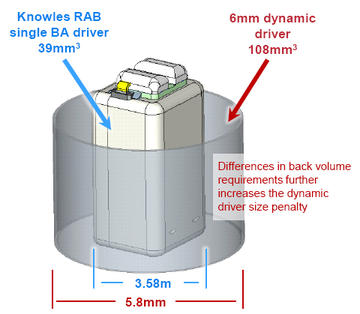In-Ear Wearables: Achieving Superior Sound in a Smaller Package

As health and fitness enthusiasts take notice of the benefits of “wearable computing” devices, Balanced Armature driver technology stands ready to optimize their in-ear listening capabilities
The growth of the wearable computing market segment is being driven by fitness enthusiasts who love to track and record their movements, vitals, body temperature, sleep patterns, steps, speed and a whole host of other personal activities. Their goal is to improve their level of performance and, ultimately, fitness. However, much of the wearable technology that currently exists is still in its nascent stages of development with several technical challenges that need to be overcome before the technology can be optimized. In a recent article in Wireless Communications magazine titled “Applications, Challenges and Prospective in Emerging Body Area Networking Technologies,” the most prominent challenges that need to be addressed include questions of scalability in terms of data rate, power consumption and duty cycle, antenna design, sound-interference mitigation, reliability, security, privacy and energy efficiency.
That being said, the ear has been identified as an ideal place to locate the system’s information gathering apparatus as it is easy to collect biometric input such as pulse, blood pressure and blood oxygen levels from here. Additionally, locating the information gathering device in the ear allows the user to receive audio feedback during exercise, along with providing access to music playback and two-way communication. This adds to the wearable computing device’s functionality and appeal for the end-user.
When considering the construction of an in-ear wearable device, two distinct challenges that system designers are confronted with are physical size constraints and maximizing power efficiency. In other words, the optimal in-ear wearable device must be small enough to be comfortable while on the go and yet provide enough battery life to be useful. Aside from the battery, the largest component in an in-ear wearable device is often the speaker. This white paper will describe how Balanced Armature micro-acoustic sound reproduction technology is ideally suited for sound transmission in wearable computing devices. For many of these reasons virtually 100% of all hearing aids manufactured today utilize Balanced Armature technology.
Dynamic Driver Power at One-Third the Size
Knowles Corporation, Itasca, IL, originally developed Balanced Armature drivers 60 years ago for use in hearing health devices and later for earphones. This advancement enabled the design of compact, comfortable, high quality hearing health devices that could be worn all day and operated with small batteries—the same demands that are now placed on in-ear wearable devices.
The high-fidelity sound reproduction capability of Balanced Armature drivers is found in the specially constructed reed that is balanced in the static magnetic field between two magnets within the driver’s outer shell. The alternating current (AC) signal in the static coil generates a magnetic flux in the reed. This creates an imbalance in the reed and causes AC motion at the tip, producing sound of exceptional clarity in the diaphragm.

Knowles offers many lines of Balanced Armature components, but this discussion will focus on a comparison of the benefits and performance of its RAB Series Balanced Armature drivers versus small dynamic speakers.
There is a limited amount of available real estate inside an in-ear listening device. The smallest dynamic speaker available measures about 6 mm in diameter. An RAB Series driver, with a volume of 39 mm3, is about one-third the size of a typical dynamic speaker (108 mm3). So, while the size of the RAB driver is just a fraction of a dynamic speaker, equivalent sound reproduction capabilities can still be achieved.

Additionally, dynamic speakers require a significant amount of “back volume” i.e., air space immediately behind the speaker, which limits design options. In comparison, Balanced Armature drivers that require no venting do not need any back volume area. For those Balanced Armature models that do need venting, significantly less back volume space is required than with dynamic speakers. This back volume can be any air space to which the Balanced Armature is exposed to, which means it does not need to be located immediately behind the speaker but can be the sum of all air gaps between the other components.
Balanced Armature drivers also outperform the typical 6 mm dynamic speaker when it comes to design versatility. The Balanced Armature’s sound port can be placed on its end, face or sides. This packaging versatility can help with the integration of a microphone, circuit or other components based on packaging design requirements or constraints. Also, the rectangular shape of a Balanced Armature driver maximizes volume utilization because other components are more easily packed tightly around it.
Regarding power usage, the RAB driver is a better option compared to a dynamic speaker. Side-by-side performance comparisons at a frequency of 1 kHz revealed that the Knowles RAB driver consumed three times less power (0.20 to 0.63 mW) when driven with the same test voltage. This means that as overall device power consumption goes down, the power savings gained by using a Balanced Armature driver becomes more and more significant. When using a class-D amplifier to drive the speaker, the relative power savings can be even greater due to a Balanced Armature’s high impedance in the range of the Class-D switching frequency. Implementation is also easier as an external filter inductor is not required.
Poised to Serve a Growing Market
The growing trend in tracking health-and-fitness activities via wearable computing shows no signs of abating, as people continue to demand more of their bodies. They insist that the technology that helps them stay on task keeps pace with their needs. Wearable computing devices that track fitness and activity levels are here to stay and the companies that provide the components for wearable-computing systems have taken notice.
Knowles Balanced Armature micro-acoustic drivers, which, for many decades, have been the driving force in optimized hearing-aid performance, maximizes the in-ear sound reproduction capabilities for wearable computing systems in four very important and specific ways:
- Customization. In-ear wearables will have a variety of acoustic goals depending on the individual design and features, for instance, music playback, voice-only and so on. Knowles can fine-tune its Balanced Armature drivers by identifying and making proper damping and venting choices, along with the best woofer and tweeter responses in order to provide exceptional clarity and pleasing audio for virtually any use case.
- Consistent performance. Knowles individually calibrates the gain of every Balanced Armature driver for consistent, predictable performance. Knowles drivers are tested to meet stringent requirements and rigorous environmental testing is performed on each new design.
- Power savings. Knowles Balanced Armature drivers are ideally suited for battery powered in-ear wearables due to their low current consumption compared to dynamic drivers.
- Size and weight. The smaller size and lower weight of Balanced Armature drivers results in an in-ear listening device that is more comfortable for the user.
In conclusion, Balanced Armature micro-acoustic drivers have proven to be a significantly better alternative to dynamic speakers from a design, size/weight and power efficiency perspective. Users of wearable computing devices during fitness activities that feature Balanced Armature drivers will not only improve their health but allow them to enjoy a better listening experience.
Santosh Daniel is the Product Line Manager, Specialty Products for Knowles Corporation. He can be reached at +1-224-715-6661 or at santosh.daniel@knowles.com. Knowles Corporation (NYSE: KN) is a market leader and global supplier of advanced micro-acoustic solutions and specialty components serving the mobile-communications, consumer electronics, medical technology, military, aerospace and industrial markets. Knowles has a leading position in micro-electro-mechanical systems microphones, speakers and receivers that are used in smartphones, tablets and mobile handsets. Knowles is also a leading manufacturer of transducers used in hearing aids, professional and premium consumer earphones, and other medical devices and has a strong position in oscillators (timing devices) and capacitor components that enable various types of communication. Knowles’ focus on the customer, combined with unique technology, rigorous testing and global scale, helps to deliver innovative solutions and consistently dependable and precise products. Founded in 1946 and headquartered in Itasca, IL, Knowles has more than 11,000 employees in 36 locations around the world. For more information, visit www.knowles.com.
